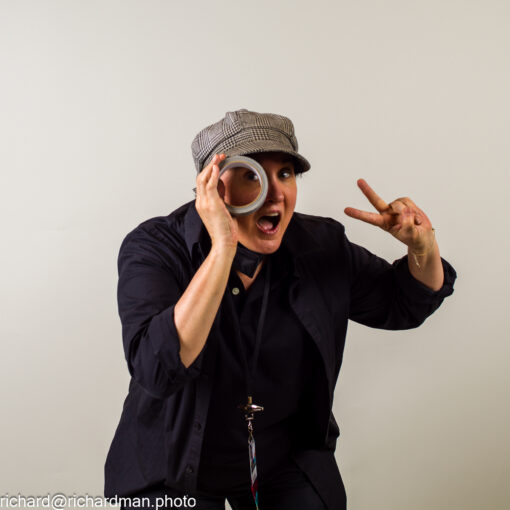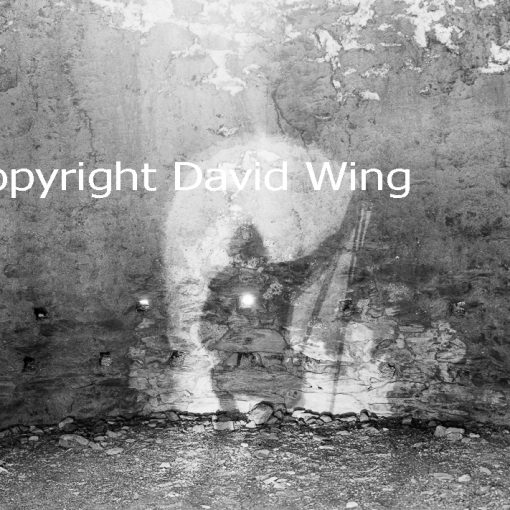A Review of the Gibellini ACN45 4×5 Large Format (LF) Camera, a post I wrote in 2016 on another site.
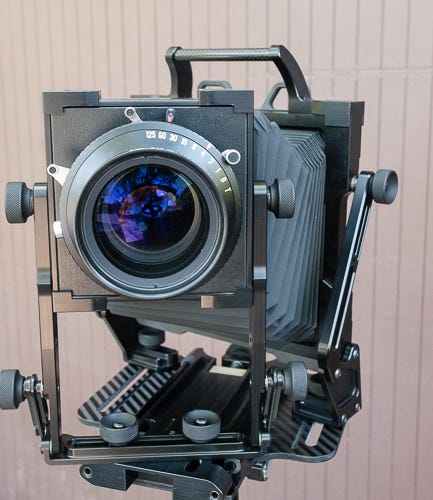
Large format photography is a dying breed. From its heyday as the medium of choice for the world’s great portrait, landscape, fine arts and commercial photographers such as Avedon, Adams, Mann, Misrach, Penn, and Roversi, large format photography is now but a niche market for a few remaining diehards. But for the few dedicated souls who appreciate the format, amazingly enough there are still a few companies such as Chamonix and Shen Hao making new LF cameras. It’s in this environment that I purchased my first 4×5 in 2012, a Chamonix F1 wooden “field camera”. It’s lightweight, folds up to “nothing”, relatively low cost, and has all the movement one needs.
Doing multiple portrait projects brought me to the “dream portrait lens”, the Cooke PS945, which is a modern recreation of the legendary Pinkham and Smith Visual Quality IV lens. After liquidating much of my Leica equipment, I was able to purchase a used one at a good price.
However, the lens in its large Copal 3 shutter challenges the Chamonix F1 to its limits: the lensboard barely fits in the front standard, and the bellow dips frequently such that I often lose about 1 cm of the negative at the bottom. Also the Chamonix does not have “zero detent” — basically meaning that it is easy to not notice when things are not in alignment, which can cause unsharpness or distortion.
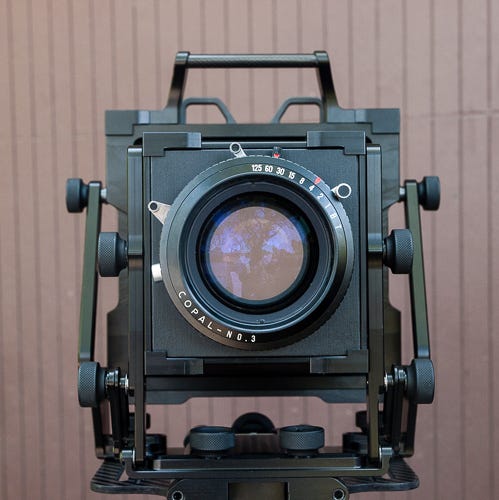
Searching for an alternative, perhaps a more sturdy but still lightweight “studio-style” monorail camera, I was surprised to find that not only are there new LF cameras being made in China, but that a new firm in Italy is crafting a rigid folding camera using carbon fiber and other similarly strong but lightweight materials.
The Gibellini Camera Company was founded in 2014 by the then 24-year-old Alessandro Gibellini. Starting with no experience with LF cameras, Gibellini is now making custom 8x10s, 11x14s, 16x20s, and occasionally, the “small” ACN 4×5.
The specifications looked good. It appeared to be a package that looked to be still reasonably lightweight, but should be able to handle a large lens without problems. So, after liquidating even more equipment, including the fabled Chamonix Saber, the lightest handholdable 4×5 ever made (yes, what you hear is a wistful sigh of regret, but such is life of a poor artist), I put a deposit on the Gibellini. After a few months of waiting, it finally arrived.
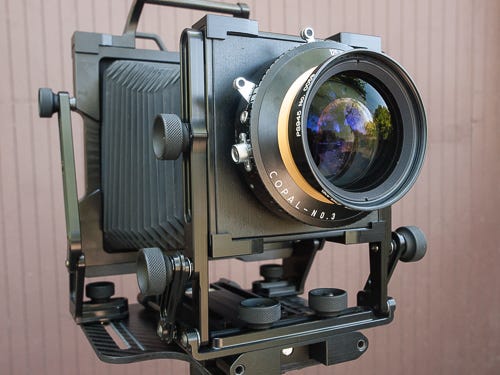
THE CONS
Let’s get the cons out of the way first:
- It’s heavy. At 5 lbs 7 oz, it’s much heavier and larger than the svelte Chamonix F1 at 3 lbs 5 oz.
- The knobs at the back standard interfere somewhat with the action of pulling out the dark slide from the film holder when in “landscape” orientation. This is more pronounced with a Riteway II holder, where the dark slide has an automatic “lock” and “unlock” mechanism.
- The ground glass is made of high impact plastic. On the one hand, it’s practically indestructible (and in fact my F1 fell once, and its ground glass shattered and had to be replaced) but when viewed under a magnifying loupe, it has a grain pattern that is much more pronounced that a traditional glass ground glass with or without a Fresnel lens attachment. I found it distracting, but I am still able to focus with it just fine.
- The focusing helical is faster turning (e.g. a small turn moves the rail farther) than the Chamonix — which is a good thing, but it occasionally feels like it may slip, although I have not seen actual evidence of slippage happening.
- The Gibellini lacks the asymmetric back tilt (which is a great feature if one uses tilt) that the Chamonix F1 has. To be fair, only a small number of LF cameras have this feature though so it’s not a criticism per se (of course all LF cameras with movement do have “regular” front and/or back tilts).
- I do not know if the back can hold a roll film adapter or a Grafmatic, although I doubt it.
Did I say it’s heavy? Actually, looking at the list, clearly, the only negative of some significance is the weight issue.
However, to balance this viewpoint: I was able to hike 2.5 miles on a flat trail carrying the camera and the Cooke on my carbon Fiber Benro tripod and a very light bag. So, while an extensive hike is difficult, short hikes or “100 feet from the car” situations are certainly possible.
THE PROS
So what are the good points?
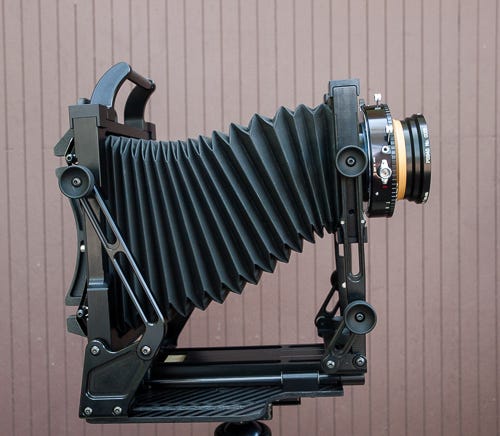
- The Gibellini handles the Cooke PS945 with aplomb. No bellows sag, even at the highest rise position.
- The camera design exudes quality. The mechanical construction is superb; the finish and even the screws and knobs announce that this is a quality instrument.
- It folds flat, and excluding the handle, which is actually quite useful to have, it does not present a profile too much larger than the Chamonix.
Overall, I really like the camera. Now then, let’s look at some of the specific features:
The native lensboard is specific to the Gibellini, at approximately 96mm square. Unlike the Chamonix, there is no trouble with the Copal 3 shutter hitting the edges of the front standard. Alessandro also makes a Linhof-Technika adapter board, which I will be acquiring shortly. This will allow my other lenses on Technika lensboards to be used. (I’d imagine he can make adapters for other camera boards as well.)
To remove the lensboard or to rotate the back, you move the plastic retainers on top to the outer positions. Note that the retainers on the front standard also hold the bellows in place, so make sure the bellows remains attached when you move the retainers back.
The bellows draw is about 320mm. I have a 360mm lens for which Alessandro is making an extension lensboard. I believe the shortest lens it can handle is in the 65–75mm range.
Alessandro recommends that the back standard be set at either the farthest or closest end, and uses the helical to adjust the focusing. This means that for any lens shorter than 200mm or so, the camera back standard sits at the front of the body. Some people may view this as a negative, but it really is just different, and not “worse”.
Also, while there is no marking on the body to position the back standard in intermediate positions, there is no reason why you cannot do it if you choose, just as with the Chamonix or other LF cameras. You just have to eyeball to make sure that the standard looks parallel to the front standard.
To fold or unfold the camera, you have to use the helical to move the front standard to far forward so that the mechanism will clear the bellows. I won’t try to explain it as it is a visual thing, but once you try it, you will see what I mean.
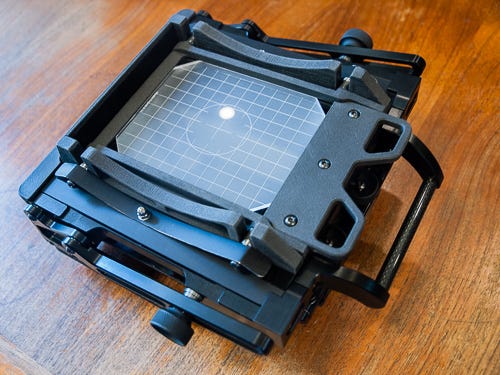
Some Sample Photos
While I have not created any portraits yet with the combo, I have no doubt that it will work as admirably as these two images indicate:
A ¼ second exposure in the Avenue of the Giants redwood forest. The wind is blowing but the camera is rock steady.
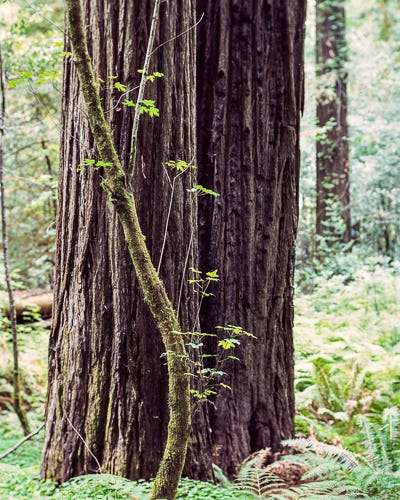
Carson “Pink Lady” house in Eureka, CA. This house sits opposite of the Carson Mansion. The light through the stained glass is exquisite.
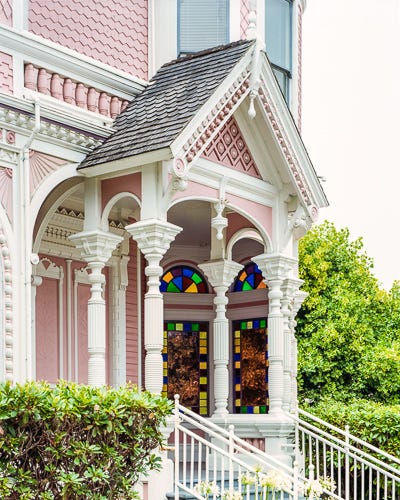
What can the Cooke PS945 do as a portrait lens? Here’s an example (on the Chamonix F1):
Karen costuming as “The Black Queen”, part of my “Transformations:Cosplay” project
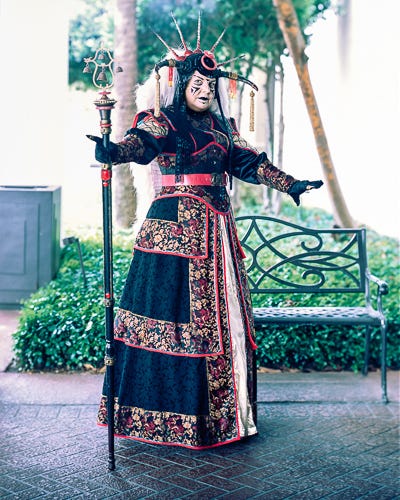
In Conclusion: other than the weight issue, the Gibellini is just about perfect for my needs. This means that I will retain the Chamonix F1 for hiking and portable use, and once I get my Technika adapter board, I will be able to use my other lens on the Gibellini as well.
I will be taking the camera to do my portrait projects next month, and if warranted, I will write a follow-up on its portrait behavior. Generally though, I have high hopes that it will make my process a little smoother, without having to fight with bellows sag, or loose knobs and nuts.
(This was a post I wrote on my own site in July 2016)

